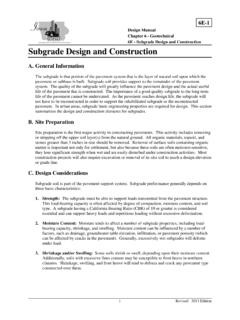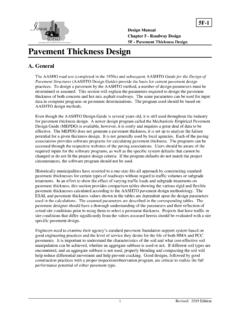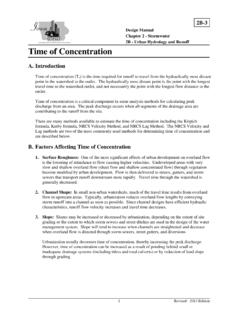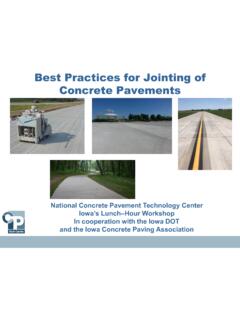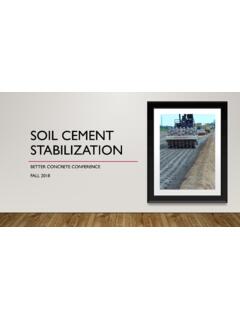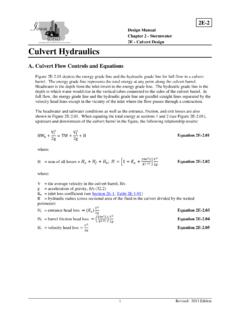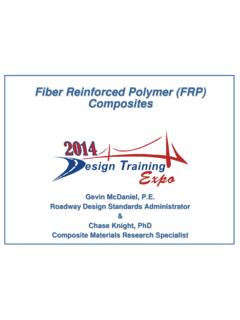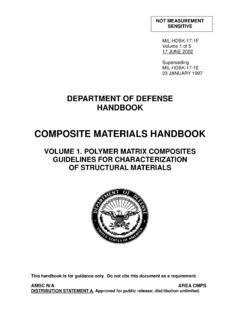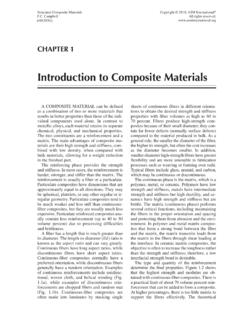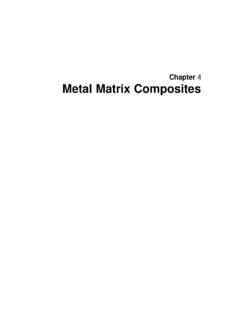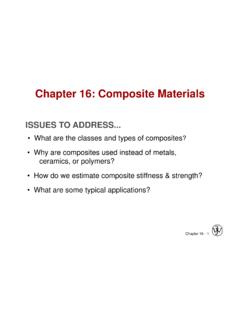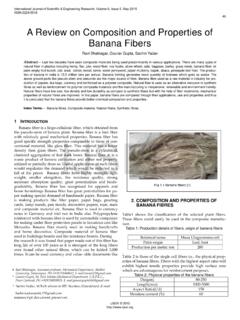Transcription of Fiber Reinforced Polymer (FRP) ACI Guidelines and Field …
1 Fiber Reinforced Polymer (FRP). ACI Guidelines and Field Installations John P. Busel, FACI. National Concrete Consortium April 25, 2018. Coeur d'Alene, ID. Outline About ACMA. Introduction FRP Materials FRP Bars Standards & Specifications Applications Summary About ACMA. World's largest composites trade association representing the entire composites industry supply chain: Material Suppliers Manufacturers & Distributors Composites Industry 3000+ Companies 280,000+ employees North America $30 Billion Industry Industry Academia Consultants 3. ACMA's Industry Council Mission - Promote the use and growth of FRP. reinforcement (rebar, tendons & grids) in concrete and masonry applications through development of quality procedures, industry specifications, performance standards, and Field application Guidelines .
2 What are Composites? Fiber Reinforced Polymers (FRP). Composites defined as: materials created by the combination of two or more materials, to form a new and useful material with enhanced properties that are superior to those of the individual constituents alone Composites material . Engineered materials which consist of more than one material type. Combination of Polymer matrix and Fiber reinforcement FRP Materials Constituents What is FRP? Fibers matrix ( Polymer ). Provide strength and Protects and transfers stiffness load between fibers Glass, Basalt, Carbon, Polyester, Epoxy, Aramid Vinyl Ester, Urethane Fiber CompositesMatrix Creates a material with attributes superior to either component alone! fibers and matrix both play critical roles in the composites FRP Composites Rebar Features Impervious to chloride ion and chemical attack Tensile strength is greater that steel the weight of steel Transparent to magnetic fields and radar frequencies Electrically non-conductive Thermally non-conductive Fiber types: glass, basalt (emerging technology).
3 And carbon Where should FRP rebar be used? Corrosion: Any concrete member susceptible to corrosion by chloride ions or chemicals Alternative: To epoxy, galvanized, or stainless steel rebars Electro-magnetic: Any concrete member requiring non-ferrous reinforcement (toll booth area). Mining and tunneling: where machinery will consume the Reinforced member Applications requiring Thermal non-conductivity Why is FRP different from steel? FRP is Anisotropic High strength in the direction of the fibers This anisotropic behavior affects the shear strength, dowel action, and bond performance FRP does not exhibit yielding: the material is linear elastic until failure Design should account for lack of ductility Member does have substantial deformability You design FRP different than steel Tensile Stress-Strain Characteristics of Reinforcement Fibers 400.
4 FRP composite Types Linear elastic CFRP behavior to AFRP. 300 GFRP failure 2000 MPa Tensile Stress (ksi). No yielding 200. Higher Ultimate 1000 MPa Strength 100. Lower Strain at Failure Typical Steel Rebar 0. 0 1 2 3. Tensile Strain (%). FRP Bar Properties Compared to Steel Steel GFRP CFRP. Yield Stress ksi 40 - 75 N/A N/A. (MPa) (276 - 517). Tensile Strength ksi 70 - 100 70 - 230 87 - 535. (MPa) (483 - 690) (483 - 1600) (600 - 3690). Elastic Modulus X 103 ksi 29 - - 84. (MPa) (200) (35 - 51) (120 - 580). Yield Strain % .14 - .25 N/A N/A. Source: ACI Typical GFRP Bar Properties Bar Nominal Nominal Guaranteed Guaranteed Designation Bar Dia. Cross Tensile Ultimate (in.) Sectional Strength Tensile Force Area (in2) (ksi) (kip).
5 2 130 3 3/8 120 4 110 5 5/8 105 6 100 7 7/8 95 8 1 90 Note: Basalt Fiber (BFRP) bar properties are equivalent or slightly higher than GFRP. Pultrusion Process Manufacturing Processes Manufacturing method used to manufacture FRP bars Heated Die Cured Profile Resin Continuous manufacturing process, unlimited lengths Bends are manufactured in the plant FRP Bar Types Materials Glass/vinylester (most used). Glass/polyurethane Basalt/epoxy Carbon/vinylester Forms Solid Round FRP bar types Surface Ribbed (a). Sand Coated (b). Helically Wrapped and Sand Coated (c). Innovation hollow bar Courtesy of composite Rebar Technologies, Inc. ACI rebar design guideline Design principles well established through extensive research Non-mandatory language ACI o 4th update to document o Current research added o Added direction on high temperature and fire effects o Design examples enhanced and reorganized.
6 Guideline documents published in Europe and Japan using ACI FRP Rebar Construction Spec ACI o Recently updated o mandatory language (standard document). GFRP bar o preparation, o placement (including cover requirements, reinforcement supports), o repair, and Field cutting ACI Standard Under Development New FRP Rebar Design Code o In 2014, ACI TAC approved a new standard development Dependent Code o Aligned with the exact chapters and structure ACI. 318-14. o Only chapters that impact FRP will be re-tooled to reflect the properties, characteristics, etc. Draft nearly finished (2019). AASHTO design guide AASHTO LRFD design guide specifications published 2009. Bridge decks and traffic railings, glass FRP (GFRP) bars Updated in 2018, presented to ASSHTO SCOBS T-6 for review and vote by AASHTO.
7 (June 2018). Design algorithms and resistance factors, detailing, material and construction specifications All concrete elements for a bridge Canada - Highway Bridge Design Code Technology transitioned from government-subsidized research projects to actual commercialization Experience gained on viability of construction management practices where FRP. reinforcement is adopted through traditional bid letting processes and competitive bidding from multiple FRP bar suppliers End-user guidance spec's International Code Council Acceptance Criteria AC454 Glass Fiber - Reinforced Polymer (GFRP). Bars for Internal Reinforcement of Concrete Members Approved June 2014. Establishes Guidelines for evaluation of an alternative reinforcement for steel- Reinforced concrete structures, where the codes do not provide design provisions, or requirements for testing and determination of physical and mechanical properties of this type of reinforcement products.
8 FRP Rebar ASTM Test Methods D7205-06(2016) Standard Test Method for Tensile Properties of Fiber Reinforced Polymer matrix composite Bars D7290-06(R17) Standard Practice for Evaluating Material Property Characteristic Values for Polymeric Composites for Civil Engineering Structural Applications D7337-12 Standard Test Method for Tensile Creep Rupture of Fiber Reinforced Polymer matrix composite Bars D7522-15 Standard Test Method for Pull-Off Strength for FRP Laminate Systems Bonded to Concrete Substrate D7565-10(2017) Standard Test Method for Determining Tensile Properties of Fiber Reinforced Polymer matrix Composites Used for Strengthening of Civil Structures D7616-11(R17) Standard Test Method for Determining Apparent Overlap Splice Shear Strength Properties of Wet Lay-Up Fiber - Reinforced Polymer matrix Composites Used for Strengthening Civil Structures D7617-11(R17) Standard Test Method for Transverse Shear Strength of Fiber - Reinforced Polymer matrix composite Bars D7705-12 Standard Test Method for Alkali Resistance of Fiber Reinforced Polymer (FRP) matrix composite Bars used in Concrete Construction D7913-14 Standard Test Method for Bond Strength of Fiber - Reinforced Polymer matrix composite Bars to Concrete by Pullout Testing D7914-14 Standard Test Method for Strength of Fiber Reinforced Polymer (FRP)
9 Bent Bars in Bend Locations D7958-17 Standard Test Method for Evaluation of Performance for FRP composite Bonded to Concrete Substrate using Beam Test D7957-17 Standard Specification for Solid Round Glass Fiber Reinforced Polymer Bars for Concrete Reinforcement Canadian Standards CSA S807 09. Qualification and QA criteria Durability Canadian report on Durability of GFRP. bars in Bridge Decks in Service for 8-10. years Multiple reports from several institutions NO Degradation of GFRP bars found ! Follow-up reports after 15 years ..a closer look Durability USA. Sierrita de la Cruz Creek Bridge, Amarillo, Texas Constructed in 2000 Material sampling following 15 years of use in 2015. 28. Durability - USA.
10 SEM analysis confirmed that there was no sign of deterioration in the GFRP. coupons. Glass fibers were intact without loss of any cross-sectional areas. Fibers were surrounded by the resin matrix and no gap nor sign indicating the loss of bond between resin and fibers, was observed. Long-term Durability of GFRP Reinforcement in Concrete: A Case Study after 15 Years of Service - O. Gooranorimi1, E. Dauer2, J. Myers3, A. Nanni4. Dept., Civil, Architectural and Environmental Engineering, 2 Dept., Biomedical Engineering, University of Miami, Coral Gables, 33146, Florida, USA. 1, 4. 3 Dept., Civil, Architecture and Environmental Engineering, Missouri University of Science and Technology, Rolla, 65409, Missouri, USA.

